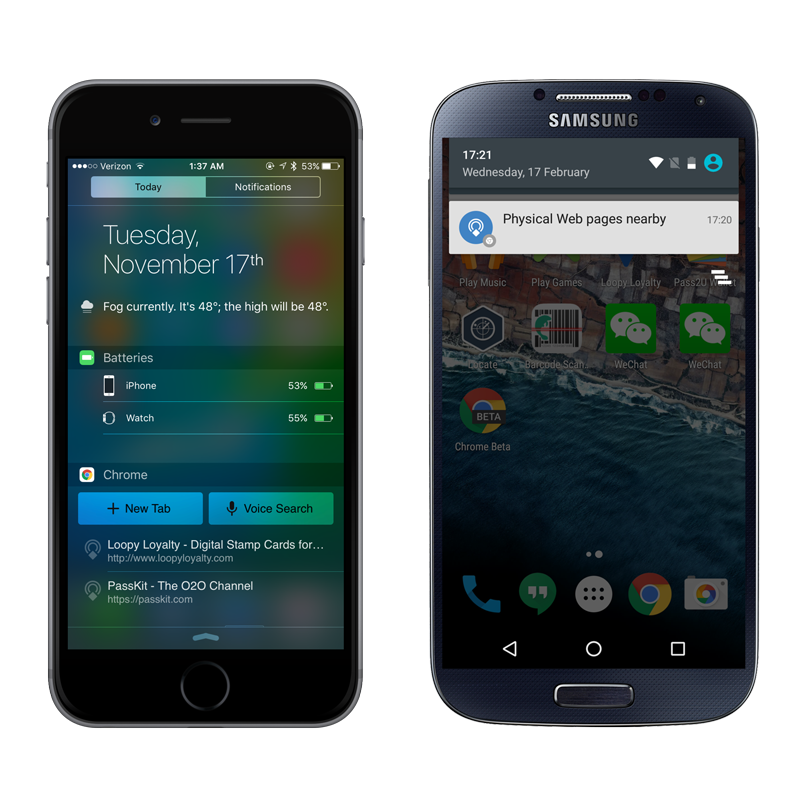As you most likely know, beacons and proximity based technology are beginning to make waves throughout many different industries. For a long time, iBeacon and Altbeacon were the only two broadcasting signals for BLE beacons. But back in July, Google released Eddystone, an open source beacon format that is compatible with both Apple and Android devices.
What makes Eddystone different?
Eddystone is different than other beacon formats because it features three frame types rather than one. Eddystone’s three frame types are:
Eddystone-UID – This frame type is similar to iBeacon. Eddystone-UID is the frame type that is used to communicate with apps to trigger push notifications or app actions.
Eddystone-URL – Otherwise known as the Physical Web, broadcasts a URL that can be picked up by Physical Web browsers. This allows for users to receive URL’s based on location and proximity to a beacon.
Eddystone-TLM (Telemetry)—This frame type is meant to work with the other two frame types and help with beacon management. Eddystone-TLM allows for you to see things like whether or not your beacon is low on battery.
Other important notes on Eddystone-
It is open format.
Eddystone has an open source format so anyone can throw out ideas and improve upon the way Eddystone works and functions. It also allows anyone to use Eddystone, not just specific companies or developers.
It works easily with both iOS and Android.
Eddystone is meant to be the all in one beacon format, so naturally it supports both major mobile platforms. This allows for your apps to perform the way they were designed on both systems using the same beacon.
How does Eddystone-UID work?
Eddystone-UID allows mobile apps to listen for signals from beacons and react accordingly. IBeacon and AltBeacon work the same way.
Beacons using the Eddystone-UID specification have to rely on an app of some sort to trigger an action. This means that in order to be able to notify a customer or send them content and information, you will need to develop that capability into an app, which your customer then needs to have installed on their device.
Another important part of Eddystone-UID is the Proximity Beacon API.
“The Proximity Beacon API is a cloud service that allows you to manage data associated with your BLE beacons using a REST interface. You can associate data with your registered beacons as attachments. Attachments are arbitrary blobs of data that are served back as messages to your Android and iOS apps through the Nearby Messages API. You can update attachments remotely, eliminating the need to physically visit each beacon.” Check out this link for more info on how to use the Proximity Beacon API.
What is the big deal with Eddystone-URL?
Eddystone-URL is also known as the Physical Web, which is an initiative from Google that wants to “unleash the core superpower of the web: interaction on demand.”
The goal of the Physical Web is to allow people to interact with web objects without the need for an app. It works is through what is called a Physical Web browser. A Physical Web browser is an app that is enabled to receive the URLs that a beacon transmits. In order for the app to receive these URL’s, the user must have bluetooth enabled and be connected to the internet. Android phones will soon have a Physical Web browser built in and the Google Chrome app for iOS allows Eddystone-URL’s to be received in the notifications tab. An Eddystone-URL signal appears like this-
To learn more about Eddystone-URL signals and how to receive them, check out How to use Eddystone-URL and what is meant by “no need for an app”.
Is Eddystone the future for beacon technology?
Google believes we are moving towards an app-less future. If that’s true, then Eddystone is no doubt the beacon format of the future. If not, Eddystone will still have a significant impact on the future of beacon technology due to its wide variety of uses and its ability to work across multiple platforms.
Regardless, the Physical Web is sure to make an impact on the Internet of Things. Being able to connect devices to the internet without the need for an app interface can open up all new possibilities for internet connected devices. To see all the capabilities of the Physical Web, check out our video series Let’s Get Physical With The Physical Web. Especially this episode on movie posters.
Have any other questions about Eddystone or the Physical Web? Let me know in the comments below.















